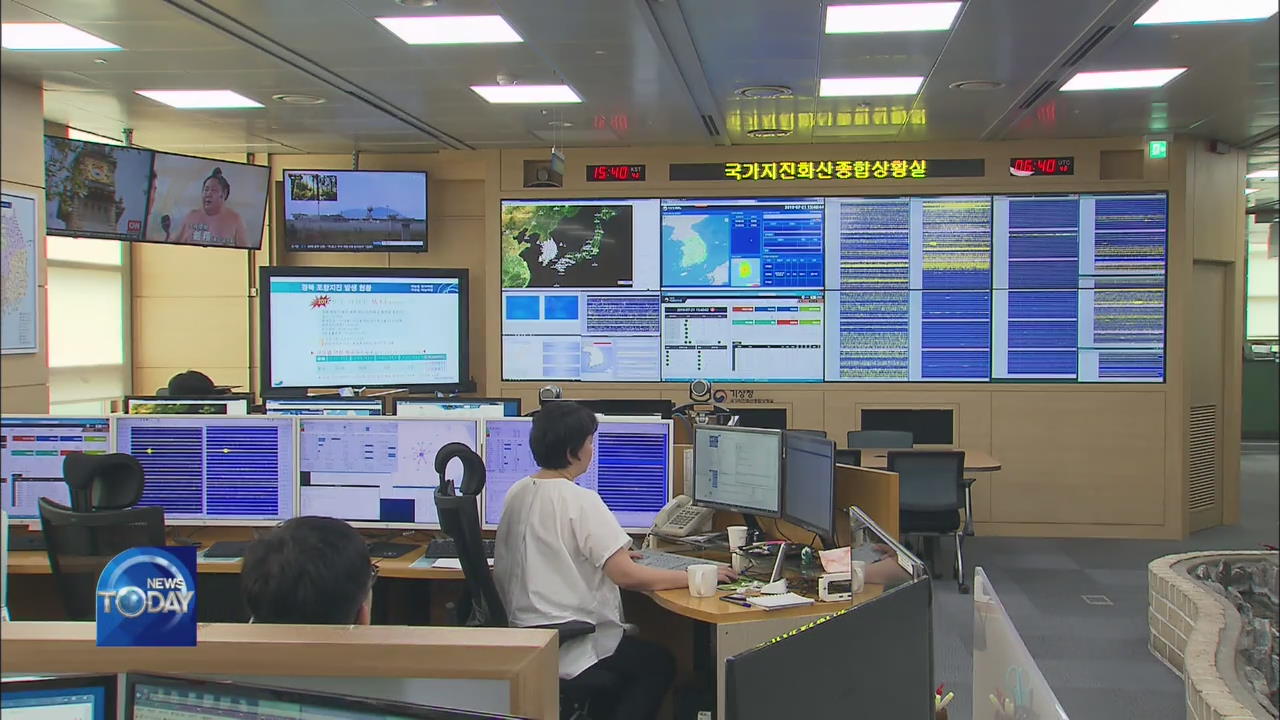STRONGEST EARTHQUAKE HITS KOREA
입력 2019.07.22 (15:05)
수정 2019.07.22 (16:45)
읽어주기 기능은 크롬기반의
브라우저에서만 사용하실 수 있습니다.
[Anchor Lead]
A 3.9-magnitude earthquake hit the city of Sangju in the southern region of Korea yesterday. It was the strongest earthquake to have occurred this year in inland Korea. We have the details
[Pkg]
An earthquake occurred at 11:04 AM yesterday morning, 11 kilometers north-northwest of Sangju, Gyeongsangbuk-do Province. At a magnitude of 3.9, the quake was classified as a level-four earthquake, which is strong enough to rattle windows. Most people indoors could feel the tremor as well. It was the strongest earthquake to strike Korea's inland region this year. A total of 29 earthquakes with a magnitude of 2.0 or higher have struck the Korean Peninsula's inland regions this year. Excluding areas in North Korea, the Gyeongbuk area has experienced the most quakes this year, with nine. In fact, the city of Sangju had been hit with a 2.0-magnitude earthquake just the day before Sunday's quake.
[Soundbite] WOO NAM-CHEOL(ANALYST, KOREA METEOROLOGICAL ADMINISTRATION) : "Aftershocks can occur since it was a 3.9-magnitude earthquake. We're preparing for a series of tremors."
The epicenter of the latest quake was an underground fault located 14 kilometers deep. Seismologists say the latest earthquake was caused by the energy that remained in the ground since the 5.8-magnitude earthquake in Gyeongju in 2016 and accumulated in the northern Gyeongsangbuk-do region. But this is only conjecture, as more analyses on underground faults are needed to determine the exact cause and when and where the next quake could strike. So far, no data have been compiled on the geological faults running beneath the Korean Peninsula. The Ministry of Interior and Safety launched a study of active faults along the Korean Peninsula following the Gyeongju earthquake, but it only details surface faults, not those deep underground.
[Soundbite] PROF. HONG TAE-KYUNG(YONSEI UNIV.) : "We couldn't find a single surface fault that causes earthquakes. In a special case like the Korean Peninsula, we have to find faults that lie deep underground."
Experts stress that although earthquakes cannot be predicted, thorough studies can help determine the likelihood of earthquakes.
A 3.9-magnitude earthquake hit the city of Sangju in the southern region of Korea yesterday. It was the strongest earthquake to have occurred this year in inland Korea. We have the details
[Pkg]
An earthquake occurred at 11:04 AM yesterday morning, 11 kilometers north-northwest of Sangju, Gyeongsangbuk-do Province. At a magnitude of 3.9, the quake was classified as a level-four earthquake, which is strong enough to rattle windows. Most people indoors could feel the tremor as well. It was the strongest earthquake to strike Korea's inland region this year. A total of 29 earthquakes with a magnitude of 2.0 or higher have struck the Korean Peninsula's inland regions this year. Excluding areas in North Korea, the Gyeongbuk area has experienced the most quakes this year, with nine. In fact, the city of Sangju had been hit with a 2.0-magnitude earthquake just the day before Sunday's quake.
[Soundbite] WOO NAM-CHEOL(ANALYST, KOREA METEOROLOGICAL ADMINISTRATION) : "Aftershocks can occur since it was a 3.9-magnitude earthquake. We're preparing for a series of tremors."
The epicenter of the latest quake was an underground fault located 14 kilometers deep. Seismologists say the latest earthquake was caused by the energy that remained in the ground since the 5.8-magnitude earthquake in Gyeongju in 2016 and accumulated in the northern Gyeongsangbuk-do region. But this is only conjecture, as more analyses on underground faults are needed to determine the exact cause and when and where the next quake could strike. So far, no data have been compiled on the geological faults running beneath the Korean Peninsula. The Ministry of Interior and Safety launched a study of active faults along the Korean Peninsula following the Gyeongju earthquake, but it only details surface faults, not those deep underground.
[Soundbite] PROF. HONG TAE-KYUNG(YONSEI UNIV.) : "We couldn't find a single surface fault that causes earthquakes. In a special case like the Korean Peninsula, we have to find faults that lie deep underground."
Experts stress that although earthquakes cannot be predicted, thorough studies can help determine the likelihood of earthquakes.
■ 제보하기
▷ 카카오톡 : 'KBS제보' 검색, 채널 추가
▷ 전화 : 02-781-1234, 4444
▷ 이메일 : kbs1234@kbs.co.kr
▷ 유튜브, 네이버, 카카오에서도 KBS뉴스를 구독해주세요!
- STRONGEST EARTHQUAKE HITS KOREA
-
- 입력 2019-07-22 15:20:22
- 수정2019-07-22 16:45:26

[Anchor Lead]
A 3.9-magnitude earthquake hit the city of Sangju in the southern region of Korea yesterday. It was the strongest earthquake to have occurred this year in inland Korea. We have the details
[Pkg]
An earthquake occurred at 11:04 AM yesterday morning, 11 kilometers north-northwest of Sangju, Gyeongsangbuk-do Province. At a magnitude of 3.9, the quake was classified as a level-four earthquake, which is strong enough to rattle windows. Most people indoors could feel the tremor as well. It was the strongest earthquake to strike Korea's inland region this year. A total of 29 earthquakes with a magnitude of 2.0 or higher have struck the Korean Peninsula's inland regions this year. Excluding areas in North Korea, the Gyeongbuk area has experienced the most quakes this year, with nine. In fact, the city of Sangju had been hit with a 2.0-magnitude earthquake just the day before Sunday's quake.
[Soundbite] WOO NAM-CHEOL(ANALYST, KOREA METEOROLOGICAL ADMINISTRATION) : "Aftershocks can occur since it was a 3.9-magnitude earthquake. We're preparing for a series of tremors."
The epicenter of the latest quake was an underground fault located 14 kilometers deep. Seismologists say the latest earthquake was caused by the energy that remained in the ground since the 5.8-magnitude earthquake in Gyeongju in 2016 and accumulated in the northern Gyeongsangbuk-do region. But this is only conjecture, as more analyses on underground faults are needed to determine the exact cause and when and where the next quake could strike. So far, no data have been compiled on the geological faults running beneath the Korean Peninsula. The Ministry of Interior and Safety launched a study of active faults along the Korean Peninsula following the Gyeongju earthquake, but it only details surface faults, not those deep underground.
[Soundbite] PROF. HONG TAE-KYUNG(YONSEI UNIV.) : "We couldn't find a single surface fault that causes earthquakes. In a special case like the Korean Peninsula, we have to find faults that lie deep underground."
Experts stress that although earthquakes cannot be predicted, thorough studies can help determine the likelihood of earthquakes.
A 3.9-magnitude earthquake hit the city of Sangju in the southern region of Korea yesterday. It was the strongest earthquake to have occurred this year in inland Korea. We have the details
[Pkg]
An earthquake occurred at 11:04 AM yesterday morning, 11 kilometers north-northwest of Sangju, Gyeongsangbuk-do Province. At a magnitude of 3.9, the quake was classified as a level-four earthquake, which is strong enough to rattle windows. Most people indoors could feel the tremor as well. It was the strongest earthquake to strike Korea's inland region this year. A total of 29 earthquakes with a magnitude of 2.0 or higher have struck the Korean Peninsula's inland regions this year. Excluding areas in North Korea, the Gyeongbuk area has experienced the most quakes this year, with nine. In fact, the city of Sangju had been hit with a 2.0-magnitude earthquake just the day before Sunday's quake.
[Soundbite] WOO NAM-CHEOL(ANALYST, KOREA METEOROLOGICAL ADMINISTRATION) : "Aftershocks can occur since it was a 3.9-magnitude earthquake. We're preparing for a series of tremors."
The epicenter of the latest quake was an underground fault located 14 kilometers deep. Seismologists say the latest earthquake was caused by the energy that remained in the ground since the 5.8-magnitude earthquake in Gyeongju in 2016 and accumulated in the northern Gyeongsangbuk-do region. But this is only conjecture, as more analyses on underground faults are needed to determine the exact cause and when and where the next quake could strike. So far, no data have been compiled on the geological faults running beneath the Korean Peninsula. The Ministry of Interior and Safety launched a study of active faults along the Korean Peninsula following the Gyeongju earthquake, but it only details surface faults, not those deep underground.
[Soundbite] PROF. HONG TAE-KYUNG(YONSEI UNIV.) : "We couldn't find a single surface fault that causes earthquakes. In a special case like the Korean Peninsula, we have to find faults that lie deep underground."
Experts stress that although earthquakes cannot be predicted, thorough studies can help determine the likelihood of earthquakes.
이 기사가 좋으셨다면
-
좋아요
0
-
응원해요
0
-
후속 원해요
0










![[HEADLINE]](https://news.kbs.co.kr/data/news/2019/07/22/4247148_10.jpg)



![[단독] 김민석 총리, 취임 첫 일정으로 ‘송미령 반대’ 농민단체 농성장 방문](/data/news/2025/07/03/20250703_YUTdgQ.png)
![[단독] ‘스테로이드’부터 ‘임신중지약’까지…해외 의약품 불법 유통 11만 건](/data/news/2025/07/03/20250703_qpUU1y.png)

이 기사에 대한 의견을 남겨주세요.